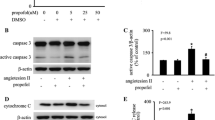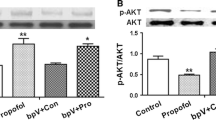Abstract
Purpose
Angiotensin II (Ang II) has been shown to be involved in neurological disorders. Propofol demonstrated neuroprotective effects in neurons.
Methods
Mouse hippocampal HT22 cells were pre-treated with propofol, followed by Ang II treatment. The expression of synaptic proteins (synapsin I and PSD95) was examined. The effects of propofol on Ang II-induced NADPH oxidase expression and superoxide anion generation were examined. The effects of propofol on intracellular calcium concentration, the activation of calcium/calmodulin-dependent protein kinase II (CaMKII), and protein kinase C (PKC) were measured.
Results
Ang II reduced the expression of synapsin I and PSD95, which was attenuated by propofol. Ang II-induced effects were blocked by Ang II type 1 receptor (AT1 receptor) blocker. Ang II induced the expression of NADPH oxidase and caused superoxide anion accumulation, which were attenuated by propofol. In addition, propofol induced intracellular calcium concentration, and activated CaMKII as well as PKCβ. Importantly, the Ang II-mediated effects were diminished by α-tocopherol, and the propofol-mediated effects were alleviated by calcium chelator, CaMKII inhibitor, and PKCβ inhibitor.
Conclusion
Ang II, via AT1 receptor, induced oxidative stress and reduced the expression of synapsin I and PSD95 in HT22 cells. Propofol may increase synapsin I and PSD95 expression by inhibiting oxidative stress and stimulating calcium signaling pathway.





Similar content being viewed by others
References
Buckley JP, BickertonI RK, Halliday RP, Kato H. Central effects of peptides on the cardiovascular system. Ann N Y AcadSci. 1963;104:299–311.
Leung PS. The peptide hormone angiotensin II: its new functions in tissues and organs. Curr Protein PeptSci. 2004;5:267–73.
Deliu E, Brailoiu GC, Eguchi S, Hoffman NE, Rabinowitz JE, Tilley DG, Madesh M, Koch WJ, Brailoiu E. Direct evidence of intracrine angiotensin II signaling in neurons. Am J Physiol Cell Physiol. 2014;306:736–44.
Wang BR, Shi JQ, Zhang YD, Zhu DL, Shi JP. Angiotensin II does not directly affect Aβ secretion or β-/γ-secretase activity via activation of angiotensin II type 1 receptor. Neurosci Lett. 2011;500:103–7.
Wu CY, Zha H, Xia QQ, Yuan Y, Liang XY, Li JH, Guo ZY, Li JJ. Expression of angiotensin II and its receptors in activated microglia in experimentally induced cerebral ischemia in the adult rats. Mol Cell Biochem. 2013;382:47–58.
Inaba S, Iwai M, Furuno M, Tomono Y, Kanno H, Senba I, Okayama H, Mogi M, Higaki J, Horiuchi M. Continuous activation of renin-angiotensin system impairs cognitive function in renin/angiotensinogen transgenic mice. Hypertension. 2009;53:356–62.
Chen J, Chen W, Zhu M, Zhu Y, Xu P, Miao C. Angiotensin II-induced mouse hippocampal neuronal HT22 cell apoptosis was inhibited by propofol: role of neuronal nitric oxide synthase and metallothinonein-3. Neuroscience. 2015;305:117–27.
Pan HL. Brain angiotensin II and synaptic transmission. Neuroscientist. 2004;10:422–31.
Wang J, Jin L, Zhu Y, Zhou X, Yu R, Gao S. Research progress in NOS1AP in neurological and psychiatric diseases. Brain Res Bull. 2016;125:99–105.
Proctor DT, Coulson EJ, Dodd PR. Reduction in post-synaptic scaffolding PSD-95 and SAP-102 protein levels in the alzheimer inferior temporal cortex is correlated with disease pathology. J Alzheimers Dis. 2010;21:795–811.
Chen J, Chen W, Zhu M, Zhu Y, Yin H, Tan Z. Propofol attenuates angiotensin II-induced apoptosis in human coronary artery endothelial cells. Br J Anaesth. 2011;107:525–32.
Cui DR, Wang L, Jiang W, Qi AH, Zhou QH, Zhang XL. Propofol prevents cerebral ischemia-triggered autophagy activation and cell death in the rat hippocampus through the NF-κB/p53 signaling pathway. Neuroscience. 2013;246:117–32.
He J, Huang C, Jiang J, Lv L. Propofol exerts hippocampal neuron protective effects via up-regulation of metallothionein-3. Neurol Sci. 2013;34:165–71.
Shi SS, Yang WZ, Chen Y, Chen JP, Tu XK. Propofol reduces inflammatory reaction and ischemic brain damage in cerebral ischemia in rats. Neurochem Res. 2014;39:793–9.
Korkotian E, Oni-Biton E, Segal M. The role of the store-operated calcium entry channel orai1 in cultured rat hippocampal synapse formation and plasticity. J Physiol. 2017;595:125–40.
Lee HY, Weon JB, Ryu G, Yang WS, Kim NY, Kim MK, Ma CJ. Neuroprotective effect of Aronia melanocarpa extract against glutamate-induced oxidative stress in HT22 cells. BMC Complement Altern Med. 2017;17:207.
Von B und Halbach, Albrecht O. D. The CNS renin-angiotensin system. Cell Tissue Res. 2006;326:599–616.
Bali A, Jaggi AS. Angiotensin II-triggered kinase signaling cascade in the central nervous system. Rev Neurosci. 2016;27:301–15.
Wright JW, Harding JW. The brain renin-angiotensin system: a diversity of functions and implications for CNS diseases. Pflugers Arch. 2013;465:133–51.
Mogi M, Iwanami J, Horiuchi M. Roles of brain angiotensin II in cognitive function and dementia. Int J Hypertens.2012;169649.
Rouch L, Cestac P, Hanon O, Cool C, Helmer C, Bouhanick B, Chamontin B, Dartigues JF, Vellas B, Andrieu S. Antihypertensive drugs, prevention of cognitive decline and dementia: a systematic review of observational studies, randomized controlled trials and meta-analyses, with discussion of potential mechanisms. CNS Drugs. 2015;29:113–30.
Kehoe PG, Hibbs E, Palmer LE, Miners JS. Angiotensin-III is Increased in alzheimer’s disease in association with amyloid-β and tau pathology. J Alzheimers Dis. 2017;58:203–14.
Zheng J, Li G, Chen S, Bihl J, Buck J, Zhu Y, Xia H, Lazartigues E, Chen Y, Olson JE. Activation of the ACE2/Ang-(1–7)/Mas pathway reduces oxygen-glucose deprivation-induced tissue swelling, ROS production, and cell death in mouse brain with angiotensin II overproduction. Neuroscience. 2014;273:39–51.
Droz B. Renewal of synaptic proteins. Brain Res. 1973;62:383–94.
Zimmerman MC. Angiotensin II and angiotensin-1–7 redox signaling in the central nervous system. Curr Opin Pharmacol. 2011;11:138–43.
Zhao HR, Jiang T, Tian YY, Gao Q, Li Z, Pan Y, Wu L, Lu J, Zhang YD. Angiotensin II triggers apoptosis via enhancement of NADPH oxidase-dependent oxidative stressin a dopaminergic neuronal cell line. Neurochem Res. 2015;40:854–63.
Davisson RL, Oliverio MI, Coffman TM, Sigmund CD. Divergent functions of angiotensin II receptor isoforms in the brain. J Clin Invest. 2000;106:103–6.
Bild W, Hritcu L, Stefanescu C, Ciobica A. Inhibition of central angiotensin II enhances memory function and reduces oxidative stress status in rat hippocampus. Prog Neuropsycho Pharmacol Biol Psychiatry. 2013;43:79–88.
Gaur V, Kumar A. Neuroprotective potentials of candesartan, atorvastatin and their combination against stroke induced motor dysfunction. Inflammopharmacology 19:205–214.
Zhang TL, Fu JL, Geng Z, Yang JJ, Sun XJ. The neuroprotectiveeffect of losartan through inhibiting AT1/ASK1/MKK4/JNK3 pathway following cerebral I/R in rat hippocampal CA1 region. CNS Neurosci Ther. 2012;18:981–7.
Marchese NA, Artur de laVillarmois E, Basmadjian OM, Perez MF, Baiardi G, Bregonzio C. Brain angiotensin II AT1 receptors are involved in the acute and long-term amphetamine-induced neurocognitive alterations. Psychopharmacology. 2016;233:795–807.
Li Z, Cao Y, Li L, Liang Y, Tian X, Mo N, Liu Y, Li M, Chui D, Guo X. Prophylactic angiotensin type 1 receptor antagonism confers neuroprotection in an aged rat model of postoperative cognitive dysfunction. Biochem Biophys Res Commun. 2014;449:74–80.
Li J, Culman J, Hörtnagl H, Zhao Y, Gerova N, Timm M, Blume A, Zimmermann M, Seidel K, Dirnagl U, Unger T. Angiotensin AT2 receptor protects against cerebral ischemia-induced neuronal injury. FASEB J. 2005;19:617–9.
Shenoy UV, Richards EM, Huang XC, Sumners C. Angiotensin II type 2 receptor-mediated apoptosis of cultured neurons from newborn rat brain. Endocrinology. 1999;140:500–9.
Von B und Halbach, Walther O, Bader T, Albrecht M. D. Genetic deletion of angiotensin AT2 receptor leads to increased cell numbers in different brain structures of mice. Regul Pept. 2001;99:209–16.
Xu Z, Lu Y, Wang J, Ding X, Chen J, Miao C. The protective effect of propofol against TNF-α-induced apoptosis was mediated via inhibiting iNOS/NO production and maintaining intracellular Ca2+ homeostasis in mouse hippocampal HT22 cells. Biomed P. 2017;91:664–672
Shao H, Zhang Y, Dong Y, Yu B, Xia W, Xie Z. Chronic treatment with anesthetic propofol improves cognitive function and attenuates caspase activation in both aged and alzheimer’s disease transgenic mice. J Alzheimers Dis. 2014;41:499–513.
Sagara Y, Hendler S, Khoh-Reiter S, Gillenwater G, Carlo D, Schubert D, Chang J. Propofol hemisuccinate protects neuronal cells from oxidative injury. J Neurochem. 1999;73:2524–30.
Delgado-Marín L, Sánchez-Borzone M, García DA. Neuroprotective effects of gabaergic phenols correlated with their pharmacological and antioxidant properties. Life Sci. 2017;175:11–5.
Wang S, Song T, Leng C, Lan K, Ning J, Chu H. Propofol protects against the neurotoxicity of 1 methyl 4 phenylpyridinium. Mol Med Rep. 2015;13:309–14.
Zhu M, Chen J, Wen M, Sun Z, Sun X, Wang J, Miao C. Propofol protects against angiotensin II-induced mouse hippocampal HT22 cells apoptosis via inhibition of p66Shc mitochondrial translocation. Neuromolecular Med. 2014;16:772–81.
Luo T, Wu J, Kabadi SV, Sabirzhanov B, Guanciale K, Hanscom M, Faden J, Cardiff K, Bengson CJ, Faden AI. Propofol limits microglial activation after experimental brain trauma through inhibition of nicotinamide adenine dinucleotide phosphate oxidase. Anesthesiology. 2013;119:1370–88.
Wu XJ, Zheng YJ, Cui YY, Zhu L, Lu Y, Chen HZ. Propofol attenuates oxidative stress-induced PC12 cell injury via p38 MAP kinase dependent pathway. Acta Pharmacol Sin. 2007;28:1123–8.
Cui D, Wang L, Qi A, Zhou Q, Zhang X, Jiang W. Propofol prevents autophagic cell death following oxygen and glucose deprivation in PC12 cells and cerebral ischemia-reperfusion injury in rats. PLoS One. 2012;7:e35324.
Simons TJ. Calcium and neuronal function. Neurosurg Rev. 1998;11:119–29.
Chin LS, Li L, Ferreira A, Kosik KS, Greengard P. Impairment of axonal development and of synaptogenesis in hippocampal neurons of synapsin I-deficient mice. Proc Natl Acad Sci USA. 1995;92:9230–4.
Buendia I, Tenti G, Michalska P, Méndez-López I, Luengo E, Satriani M, Padín-Nogueira F, López MG, Ramos MT, García AG, Menéndez JC, León R. ITH14001, a CGP37157-nimodipine hybrid designed to regulate calcium homeostasis and oxidative stress, exerts neuroprotection in cerebral ischemia. ACS Chem Neurosci. 2017;8:67–81.
Lu Y, Gu Y, Ding X, Wang J, Chen J, Miao C. Intracellular Ca2+ homeostasis and JAK1/STAT3 pathway are involved in the protective effect of propofol on BV2 microglia against hypoxia-induced inflammation and apoptosis. PLoS One. 2017;12:e0178098.
Li X, Li W, Luo J, Wei K, Li P, Liu XB, Min S. Effects of propofol on the activation of hippocampal CaMKIIα in depressed rats receiving electroconvulsive therapy. J ECT. 2012;28:242–7.
Björnström K, Sjölander A, Schippert A, Eintrei C. A tyrosine kinase regulates propofol-induced modulation of the beta-subunit of the GABA(A) receptor and release of intracellular calcium in cortical rat neurones. Acta Physiol Scand. 2002;175:227–35.
Liang WZ, Jan CR, Lu CH. Investigation of 2,6-diisopropylphenol (propofol)-evoked Ca2+ movement and cell death in human glioblastoma cells. Toxicol In Vitro. 2012;26:862–71.
Wickley PJ, Yuge R, Russell MS, Zhang H, Sulak MA, Damron DS. Propofol modulates agonist-induced transient receptor potential vanilloid subtype-1 receptor desensitization via a protein kinase Cepsilon-dependent pathway in mouse dorsal root ganglion sensory neurons. Anesthesiology. 2010;113:833–44.
Lu CW, Lin TY, Chiang HS, Wang SJ. Facilitation of glutamate release from rat cerebral cortex nerve terminal by subanesthetic concentration propofol. Synapse. 2009;63:773–81.
Author information
Authors and Affiliations
Corresponding author
Ethics declarations
Conflict of interest
There is no conflict of interest.
About this article
Cite this article
Ding, X., Ju, X., Lu, Y. et al. Angiotensin II-mediated suppression of synaptic proteins in mouse hippocampal neuronal HT22 cell was inhibited by propofol: role of calcium signaling pathway. J Anesth 32, 856–865 (2018). https://doi.org/10.1007/s00540-018-2565-x
Received:
Accepted:
Published:
Issue Date:
DOI: https://doi.org/10.1007/s00540-018-2565-x




